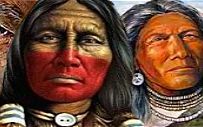 |
|
 |
 |
 |
|||
| Masikota - Sutai - Tsitsistas |
      |
cheyenne-arapaho tribe |
Artifact Replicas|Jewelry|Clothing|Figurines|Art Prints|On Sale|Closeoutscheyenne-arapaho tribe today>AUTHOR: Gayle Perez The Southern Cheyenne and Arapaho tribes have endured many hardships and changes throughout history from the Black Hills of South Dakota to the plains of Colorado and finally the open fields of Oklahoma. "We are a very traditional people who have hung on to a lot of our culture and history," said Vera Franklin, a member of the Cheyenne tribe now living in El Reno, Oklahoma, located 35 miles west of Oklahoma City. Though some of their customs and traditions have been diluted and very few of the younger generation of tribal members speak the native languages of their tribes, the pride and perseverance of two of the most famous Great Plains Indian tribes of the American West continue to thrive. As of 2004, the Cheyenne-Arapaho tribe had 11,627 members.The Oklahoma tribes were both members of the larger Cheyenne and Arapaho tribes that split in the 1800s. The southern band of the cheyenne tribe settled in Oklahoma, while the northern cheyenne bands are located in Wyoming and Montana.The Oklahoma cheyenne-arapaho tribe members no longer live on a reservation, but instead reside on tribal trust lands located throughout the western section of the state. The tribal lands are scattered over a 10-county area with the main headquarters located in Concho, a small, rural town 35 miles west of Oklahoma City. A herd of cattle and an estimated 300 buffalo graze throughout the vast, rich farmland that surrounds the headquarters. Not far from where the buffalo roam are two of the cheyenne-arapaho tribe's most consistent sources of revenue: a smoke shop that sells tobacco products and the Lucky Star Casino. The casino is one of three in Oklahoma owned by native american tribes. The Cheyenne-Arapaho tribal headquarters in Concho are composed of an administration building, a day-care center, a post office, the Willie Fletcher Wellness Center and a few dilapidated but still inhabited homes built by the Bureau of Indian Affairs. Nearby on the grounds sits an abandoned group of buildings that once served as a bureau school and cultural center. The weather-beaten school building once filled with hundreds of Indian children now sits with broken windows and overgrown by weeds, shrubs and vines. The basketball courts and baseball fields are hardly recognizable under the tall weeds and grass. The school, closed nearly 30 years ago due to bureau budget cutbacks, no longer can be repaired and should have been demolished years ago. Indian children from the area now attend public schools in the communities where they live.With cheyenne-arapaho tribal members spread throughout the region, living in rural communities with names like El Reno and Elk City, Watonga and Clinton, Geary and Concho, the Indians' daily way of life has changed some, but the customs and traditions of yesteryear remain firmly intact.Council of 44 chiefs still aliveThe cheyenne-arapaho tribe still maintains a leadership of 44 chiefs, which are entrusted to care for the cheyenne-arapaho tribe members and elders.One of the chiefs, Laird Cometsevah (pronounced Como-see-va) has not only made it his mission to take care of his people, but also to pass along the rich history of the Cheyenne-Arapaho tribe. Cometsevah, 74, doesn't hesitate to tell the history as it was passed down to him from his parents. He said the origins of the cheyenne tribe began in the Black Hills of South Dakota. "When I would ask my parents where we came from, they would tell me that 'The Almighty' placed us in the Black Hills at Bear Butte," Cometsevah said in rich storytelling fashion. "And we were given the name Cheyenne, which means 'the people.' " Cometsevah said at that time there wasn't a government system in place and therefore the people lived a very quiet life. Cometsevah said the Cheyenne were afraid of the buffalo, but all that changed one day when the Cheyenne killed one. He said as the buffalo scattered throughout the Plains, the Cheyenne would follow to hunt them down. "The Cheyenne would wander to the Rocky Mountains and on up to Canada, but they would always come back to the Black Hills," he said. Eventually, Cometsevah said, other Indian tribes settled in the Black Hills region, wanting to take the land from the Cheyenne. According to Cometsevah, legend has it that a contest was held to determine who laid claim to the land. A large, shiny silver rock was thrown into the clear water and a representative from each tribe was to jump into the water and the one that came up with the rock would be the rightful owner of the land. Cometsevah said that after all other tribal members had jumped into the water and emerged empty-handed, a Cheyenne representative jumped in and came up with the rock. "All the tribes agreed that the Cheyenne owned the Black Hills and the other tribes left. As time went along, it became the type of life where the strong overruled the weak," he said. Cometsevah said then "The Almighty" sent a child named Sweet Medicine who was provided different powers. It is the words and lessons passed on from Sweet Medicine that have provided much of the traditions that the cheyenne-arapaho tribe still hangs on to today. Among one of the stories Cometsevah told was how the five societies of the Cheyenne tribe were developed. He said Sweet Medicine, while running to Bear Butte, would appear over a hill dressed according to one of the different societies. As he ran over the next hill, he would appear dressed as another one of the societies, until he claimed all five - bowstring, elk, kit fox, dog soldier and chiefs. Once at Bear Butte, Cometsevah said that Sweet Medicine entered a cave of the four winters and the four spirits taught him songs and dances that are still performed by the Cheyenne people. "He came and taught the Cheyenne all he had learned," he said. Cometsevah said every winter, Sweet Medicine would grow old but by spring he would become young again. "Then one winter he was going on a journey on the Plains and he requested to be left alone," Cometsevah said. "That is tribal law, that whenever an elder wants to be left alone, they have to honor him." After the rest of the group got so far, Cometsevah said one was sent back to look after Sweet Medicine. When he got to the spot where Sweet Medicine had remained, there was a dogwood tree. "He left a dogwood tree to the Cheyenne people and that's why we use dogwood in our ceremonies." Cometsevah said as time passed, the Cheyenne people were granted the freedom to roam the land. "But, very seldom did the Cheyenne venture west of the Rocky Mountains. We stayed in the area," he said. When the people from Europe began moving west, Cometsevah said the Indian way of life began changing. Their freedom to roam the land ceased with the Louisiana Purchase. "The Cheyenne were told not to go beyond a point. That's when boundaries were set and that's when reservation life began," he said. Cometsevah said this follows the prophecy of Sweet Medicine who said "There would be a white person from the East who will take over your ways and your land and you will end up with nothing." Soon after, the tribes were faced with various treaties that forced them to change the location of their property. In the Treaty of 1851, the Cheyenne were given 51 million acres of land that included property from Denver to Pueblo and along the Arkansas River to western Kansas. The Treaty of 1861 moved the tribe to Southeastern Colorado. It wasn't long after that the Cheyenne suffered what is considered one of the most disgraceful acts of the Indian Wars of the Plains - the Sand Creek massacre in 1864. Under the leadership of Chief Black Kettle, more than 600 members of the Cheyenne and Arapaho tribes had settled in Sand Creek, located north of Lamar. They were attacked by Colorado militiamen who were under the command of Col. John Chivington. Though Black Kettle had raised a white flag of surrender and a U.S. flag showing their loyalty to the nation, Chivington and his men ignored the signs and attacked the tribes anyway. Despite their attempts to fight back, at least one-third of the tribe members - mostly women, children and elders - were killed. Cometsevah said in the aftermath of Sand Creek, descendents were offered animals, land and money, but "to this day we haven't collected anything yet." In 1867, the cheyenne and arapaho tribes were finally moved to western Oklahoma where they remain today. An allotment act provided for each tribal member to receive 160 acres of land, which many have since sold because they are not able to make a living off the land. "We started out with 51 million acres and we ended up with 160 acres," Cometsevah said. "But through all this, we are still the Cheyenne and they will never take that away from us." SOURCE: ©THE PUEBLO CHIEFTAIN 
Fire in the Sky Giclee Print Rosario, Teri Buy at AllPosters.com Framed Mounted |
|
||||||||||||||||||||||||||||||||||||||||||||||||||||
| ||||||||||||||||||||||||||||||||||||||||||||||||||||||
Site Designed by: Mazaska Web Design
Hosted by: HostIt4You.com
© 1999-2008 AAANativeArts.com
+5,092 on old site
file: cheyenne-arapaho tribe

